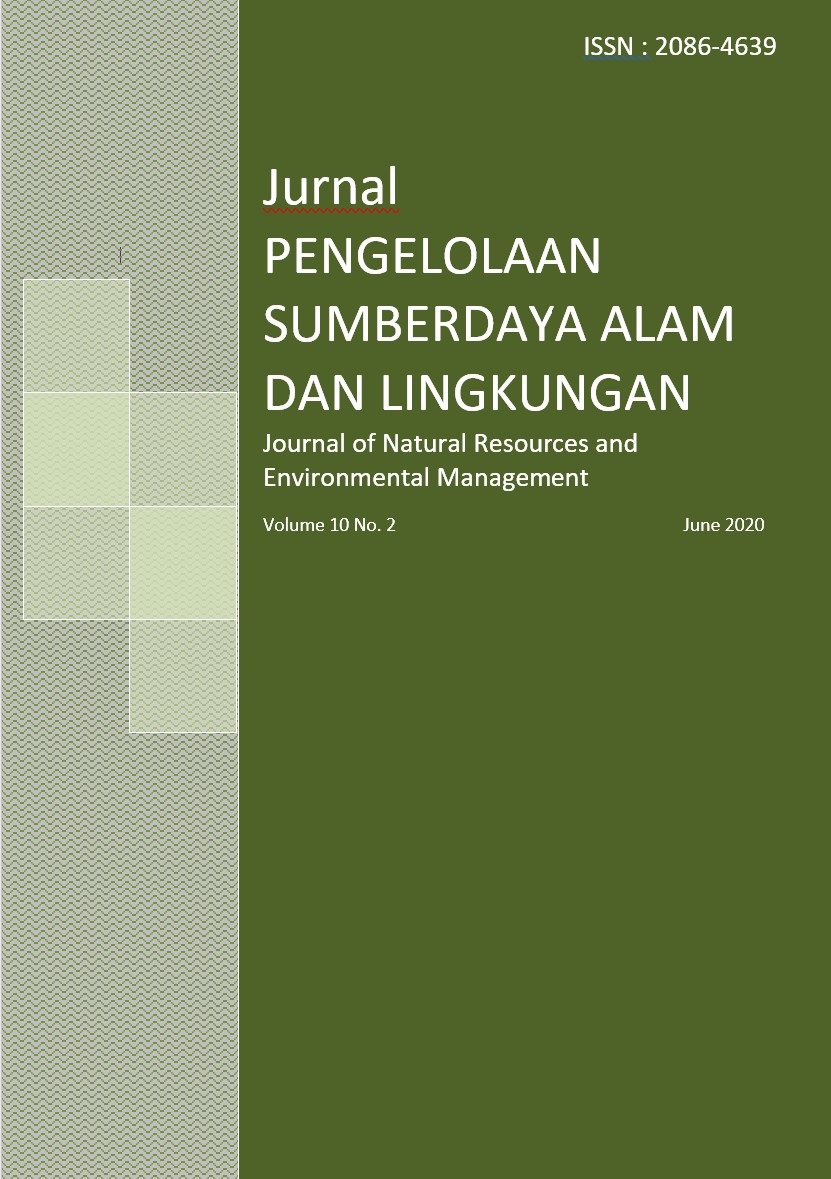Pengelolaan ekosistem mangrove untuk ruang terbuka hijau sebagai mitigasi gas rumah kaca di kawasan Sungai Tallo Kota Makassar
Abstract
One of the ecological functions of mangroves ecosystem is to store carbon. Yet, on the other hand it also has the potential to cause greenhouse gas emissions through litter degradation even though its value is lower compared to the absorption value. Based on these two facts, mangrove management as a Green Open Space in the Tallo river area of Makassar City needs to consider involving the participation of the community and the government as stakeholders. The research was conducted by desk work, literature study and respondent interviews regarding perceptions and participation in mangrove management. The results showed that the total uptake of mangrove carbon in the Tallo river in Makassar city was 351.02 tons CO2/ha, oxygen supply 255.29 O2-equivalent/ha, and the potential for global warming was 252.41 mg/ m2/hour consisting of 194, 33 mg/m2/hour of CO2 gas, 15.76 mg/m2/hour of CH4 gas, and 42.33 mg/m2/hour of N2O gas. The results of community perception and participation analysis show that around 89% of the community strongly agreed and supported the government in the effort to manage mangroves as a green open space. Based on this, the ecosystem in the Tallo river is very suitable to be managed for green open space as fresh air supplier and CO2 adsorber as well as a noise reduction from vehicle or industrial engines in Makassar city.
References
DeFries RS, Richard AH, Mattew CH, Christoper BF, David S, John T. 2002. Carbon emissions from tropical deforestation and regrowth based on satelite observation for the 1980s. PNAS 99(22):14256-14261.
Hairiah K, Rahayu S. 2007. Pengukuran Karbon Tersimpan di Berbagai Macam Penggunaan Lahan. Malang (ID): World Agroforestry Centre.
Heriyanto NM, Subiandono R. 2012. Komposisi dan struktur tegakan, biomassa dan potensi kandungan karbon hutan mangrove di taman nasional alas purwo. J Penelitian Hutan dan Konservasi Alam 9 (1): 023-032.
[IPCC] Intergovernmental Panel on Climate Change. 1990. The intergovernmental panel on climate change scientific assessment. Cambridge, UK: Cambridge University Press. pp 138-147.
[IPCC] Intergovernmental Panel on Climate Change. 2001. Climate Change 2001 : The Scientific Basis. Cambridge (GB): Cambridge University Pr.
Ilman M, Dargusch P, Dart P, Onrizal. 2016. A historical analysis of the drivers of loss and degradation of Indonesia’s mangroves. Land Use Policy. 54: 448-459.
Iswahyudi I, Kusmana C, Hidayat A, Noorachmat BP. Lingkungan biofisik hutan mangrove di Kota Langsa, Aceh. JPSL. 10(1): 98-110.hhtp://dx.doi.org/10.29244/jpsl.10.1.98-110.
[KLH] Kementerian Lingkungan Hidup. 2012. Pedoman Penyelenggaraan Inventarisasi Gas Rumah Kaca Nasional [Buku I Pedoman Umum]. Jakarta (ID). KLH.
Komiyama A, Ong JE, Poungparn S. 2008. Allometry, biomass and productivity of mangrove forest: a. review. A Botany, 89:128-137.
Oni, Kusmana C, Basuni S. 2019. Succes story rehabilitasi ekosistem mangrove di Pantai Karangsong Kabupaten Indramayu. JPSL 9(3): 447-487. http://dx.doi.org/10.29244/jpsl.9.3.477-487.
Rachmawati D, Setyobudiandi I, Hilmi E. 2014. Potensi estimasi karbon tersimpan pada vegetasi mangrove di wilayah pesisir Muara Gembong, Kabupaten Bekasi. Omni-Akuatika. 13(19): 85-91.
Rahman, Efendi H, Rusmana I, 2017. Estimasi stok dan serapan karbon pada mangrove di Sungai Tallo, Makassar. Journal Ilmu Kehutanan. 11: 19-28.
Rahman, Yulianda F, Effendi H, Rusmana I, Wardiatno Y. 2018. Fluks gas rumah kaca CO2, CH4, dan N2O pada lahan ekosistem mangrove di Sungai Tallo Makassar. Jurnal Biologi Tropis. 18(2): 149-158.
Rahman, Yulianda F, Rusmana I, Wardiatno Y. 2019. Production ratio of seedlings and density status of mangrove ecosystem in coastal areas of Indonesia. Advances in Environmental Biology. 13(6): 13-20.
Rahman, Wardiatno Y, Yulianda F, Rusmana I. 2020. Socio-ecologycal system of carbon-based mangrove ecosystem on the coast of West Muna Regency, Southeast Sulawesi, Indonesia. AACL Bioflux. 13(2): 518-528. Riani E. 2012. Perubahan Iklim dan Kehidupan Biota Akuatik. Bogor (ID): IPB Pr.
Rijal S. 2008. Kebutuhan ruang terbuka hijau di kota Makassar Tahun 2017. J Hutan dan Masyarakat, (8),1: 65-77.
Siddique HRM, Hossain M, Chowdhury KRM. 2012. Allometric relationship for estimating above-ground biomass of aegialitis rotundifolia roxb of sundarbans mangrove forest, in Bangladesh. J of Forestry Research, 23(1):23-28.
Wijanarko B. 2006. Kemungkinan penerapan co-management dalam pengelolaan ruang terbuka hijau di pantai utara kota Surabaya [Tesis]. Semarang (ID): Universitas Diponegoro.
Authors
Authors who publish with this journal agree to the following terms:
- Authors retain copyright and grant the journal right of first publication with the work simultaneously licensed under a Creative Commons Attribution License that allows others to share the work with an acknowledgement of the work's authorship and initial publication in this journal.
- Authors are able to enter into separate, additional contractual arrangements for the non-exclusive distribution of the journal's published version of the work (e.g., post it to an institutional repository or publish it in a book), with an acknowledgement of its initial publication in this journal.
- Authors are permitted and encouraged to post their work online (e.g., in institutional repositories or on their website) prior to and during the submission process, as it can lead to productive exchanges, as well as earlier and greater citation of published work (See The Effect of Open Access).






